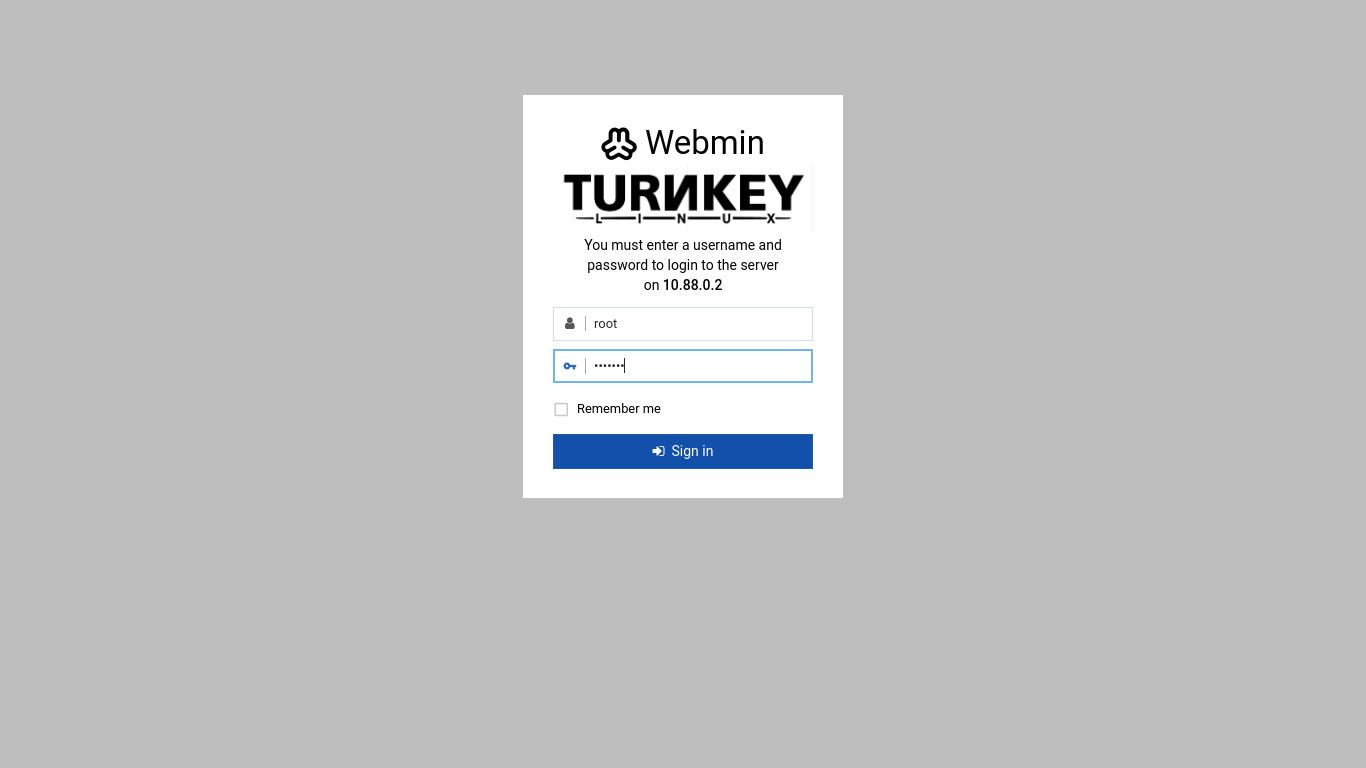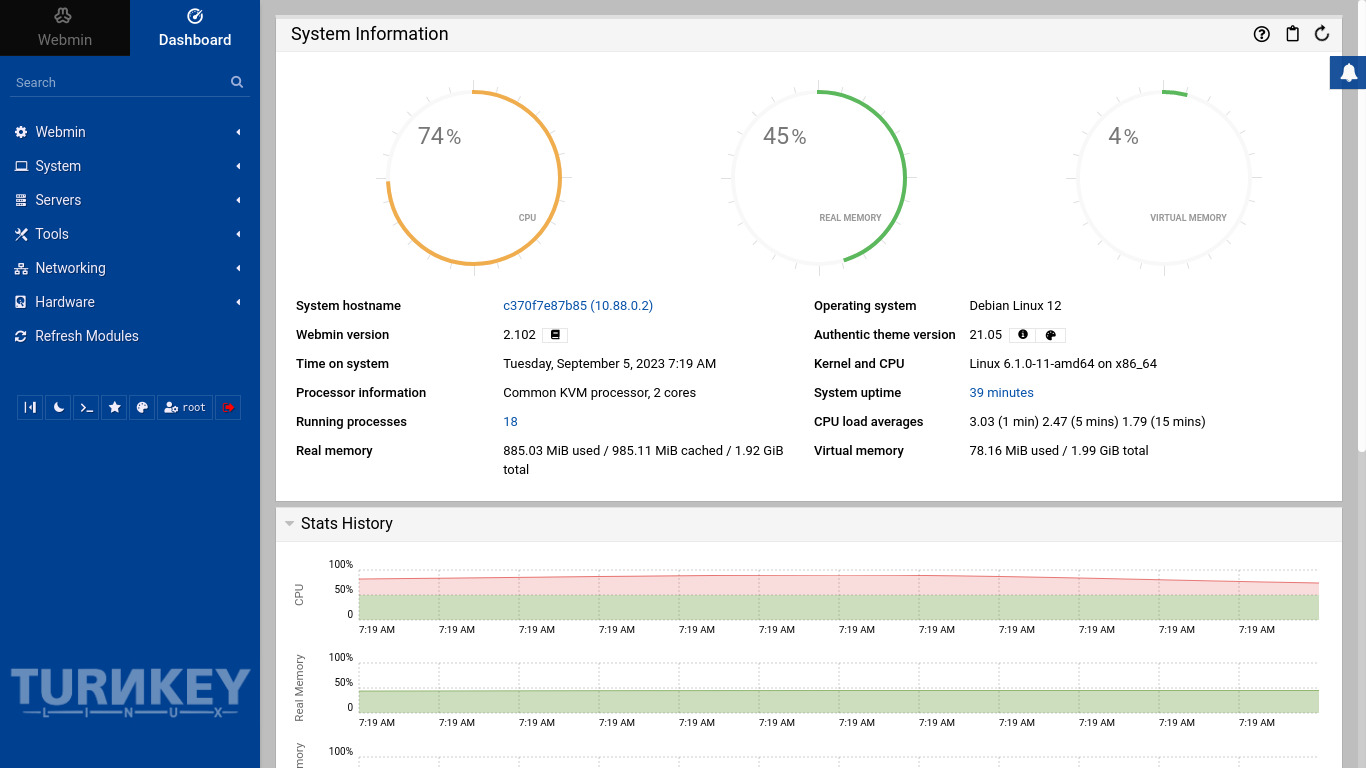You are here
TurnKey Core
Debian GNU/Linux with Batteries Included
TurnKey Core is the base operating system which all TurnKey GNU/Linux solutions share in common. It is commonly deployed standalone as a convenient starting point for custom system integrations. Benefits include automatic daily security updates, 1-click backup and restore, a web control panel, and preconfigured system monitoring with optional email alerts.
Run from browser
V 18.1
V 17.1
GitHub
Features:
- Base Operating System: Debian GNU/Linux 'stable'.
- Build formats: Deploys on bare metal, virtual machines (e.g.,
OpenStack, VMWare, VirtualBox, LXC, KVM, Xen) and in the cloud.
- ISO images: Generic installable Live CD. Installs anywhere.
- Virtual Machine images: Optimized for virtualized hardware, pre-installed and ready to run.
- Amazon Machine Image (AMI): Best launched via the TurnKey Hub.
- Free as in speech: free software with full source code and a powerful build system. Free of hidden backdoors, free from restrictive licensing and free to learn from, modify and distribute.
- Secure and easy to maintain: Auto-updated daily with latest Debian security patches. Optional monitoring and email notification of system alerts.
- 1-click backup and restore (TKLBAM): smart backup and data migration software saves changes to files, databases and package management to encrypted storage which a system can be automatically restored from.
- Dynamic DNS (HubDNS): Associates your IP with a custom domain or the free *.tklapp.com domain.
- Logical Volume Management (LVM): Instead of installing to a fixed size partition, a Logical Volume is first created by default, and this may later be expanded, even across multiple physical devices.
- Web management interface (WebUI) with built-in shell (Webmin):
- Listens on port 12321 (uses SSL).
- Modern responsive theme: 'Authentic'.
- Network modules:
- Firewall configuration (with example configuration).
- Network configuration.
- System modules:
- Backup and migration (TKLBAM).
- Configure time, date and timezone.
- Configure users and groups.
- Manage software packages.
- Change passwords.
- Journal/System logs.
- Tool modules:
- Text editor.
- Shell commands.
- Simple file upload/download.
- File manager (HTML5).
- Custom commands.
- Hardware modules:
- Partitions on local disks.
- Logical volume management.
- Simple configuration console (cli) (confconsole):
- Displays basic usage information.
- Configure networking.
- Let's Encrypt SSL/TLS certificates.
- Mail SMTP relay setup.
- Proxy settings.
- Region and timezone.
- Other global system settings.
- First boot initialization (inithooks):
- Prompt user for passwords.
- Regenerates SSL and SSH cryptographic keys.
- Installs latest security updates, unless user chooses to defer this for later.
- Command line power tools
- Smart, programmable bash shell completion: helps you get more done with fewer keystrokes.
- Support for $HOME/.bashrc.d shell hooks
- Persistent environment variables (see $HOME/.bashrc.d/penv):
penv-set pydoc /usr/share/doc/python2.7/html exit # later... cd $pydoc
- Automatic time synchronization with NTP
- Take a look at some screenshots.
Usage details & Logging in for Administration
No default passwords: For security reasons there are no default passwords. All passwords are set at system initialization time.
Ignore SSL browser warning: browsers don't like self-signed SSL certificates, but this is the only kind that can be generated automatically. If you have a domain configured, then via Confconsole Advanced menu, you can generate free Let's Encypt SSL/TLS certificates.
Username for OS system administration:
Login as root except on AWS marketplace which uses username admin.
- Point your browser to:
- https://12.34.56.789:12321/ - System control panel
- https://12.34.56.789:12320/ - Web based command line terminal
- Login with SSH client:
ssh root@12.34.56.789
Special case for AWS marketplace:
ssh admin@12.34.56.789
* Replace 12.34.56.789 with a valid IP or hostname.


